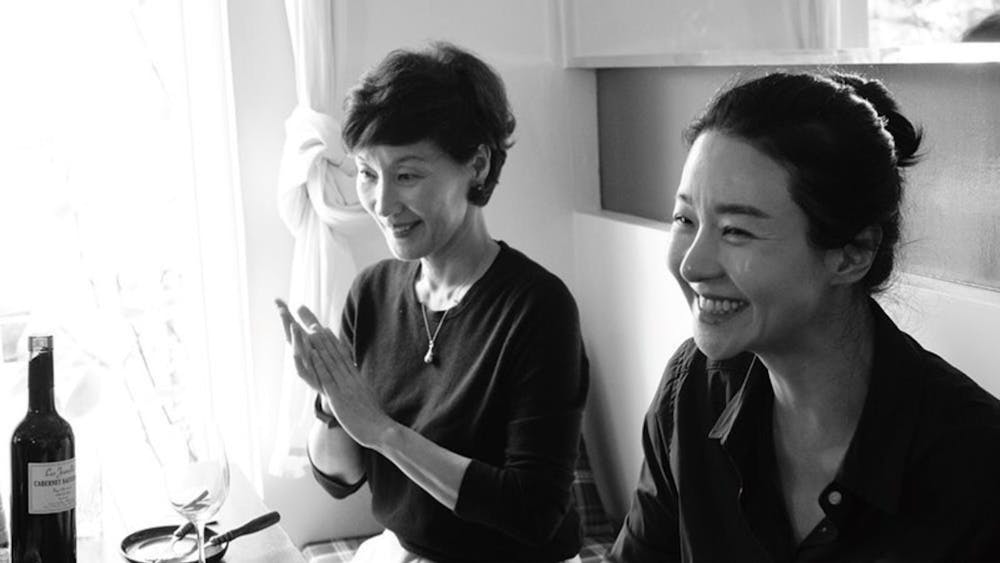Duke Cinematic Arts’ film screening program Screen/Society screened “Walk Up” at the Rubenstein Arts Center Sept. 22. More information about Screen/Society’s upcoming programming can be found here.
Alone in his bed, fetally curled, Byung-soo (Kwon Hae-hyo) attempts to sleep as the light of the still-awake world resists him. Something else is resisting him too: a conversation with his current partner about her rekindling of a friendship that he dislikes. After the conversation ends, he says to himself, “I’m better off alone anyway.”
“Walk Up,” South Korean director Hong Sang-soo’s 28th feature film in 26 years, follows Byung-soo as he visits a small, multiple-story building that contains apartments and a restaurant. Throughout the film, the building’s significance in his life only grows. Sang-soo, who cites both avant-garde artist Paul Cézanne and director Robert Bresson as influences, is obviously fascinated with reality: what creates it, shapes it and upholds it. While reality is molded and shaped, the building remains constant – it acts as both a bridge beyond and above the self-centeredness of the lead character and a vessel for his worst qualities.
Byung-soo creates his own reality and is the only one there to keep it from crumbling. In the only scene where he isn’t present, Sang-soo’s static camera stays focused on his empty chair.
The conversation between his daughter and her desired mentor is shaped by his absence. The camera notices this first (as it seems to always do in “Walk Up”), and the conversation follows. Ms. Kim (Lee Hye-young), the veteran interior designer that he is trying to get to help his daughter, Jeong-su (Park Mi-so), cannot contain her interest in the inner life of this famous director. Using a word that comes up more frequently than seemingly any other, she wants to know what Byung-soo is “really” like. Jeong-su disappoints and explains that he is almost the exact opposite of what he presents to the outside world. Desiring to keep her own reality and perceptions intact, Ms. Kim rebuts, “Isn’t the person he is outside the home him as well?”
Sang-soo, as before, has an answer: no. Proving this, more and more of Byung-soo’s life takes place in the building. What was once a place of transient visitation is now “home.” What was a man first seen as charismatic and in control is now insecure, lonely and scared. The camera is indifferent to this change.
Throughout 10-minute long scenes, the camera doesn’t move or cut once. Sang-soo extracts every drop of emotion and “reality” he can get from his characters before he decides to leave. Scenes over a lunch take the length of a lunch, only for years to pass at the behest of a musical que.
This unique pacing of our lead’s life allows him to control his reality through small vignettes. Vast swaths of time are functionally insignificant, yet one lunch, a leaky ceiling, a dinner on a terrace and another dinner at a restaurant define a portion of Byung-soo’s life.
Every vignette is framed by a meal. We are only shown the aftermath of the first two (usually punctuated by multiple drinks), but we see the entirety of the latter two. The switch between invisible and visible consumption marks the building’s switch from “place” to “home.”
In the scene prior to Byung-soo’s tormented rest, he is seen eating dinner with his partner, Sunhee (Song Seon-mi). Throughout the meal, they bicker, “stressing” Byung-soo out. He explains to Sunhee that stress hurts digestion, so they cannot talk like this while he’s eating. However, Sang-soo shows that this is the only place and time where it can happen.
Eating is left for the home, and home is where the real self is. As much as Byung-soo tries to control his reality, there are structures, both physical and ethereal, that bind him.
As an artist, he is uniquely equipped to move beyond these boundaries. In fact, everyone in this movie is an artist: Ms. Kim and Jeong-su are former painters, and Sunhee graduated from art school. Through their art, they are able to express parts of themselves and their vision of the world, yet the physicality of the building and the unflinching lens of the camera refuse to budge to their reality.
The film both begins and ends with Byung-soo’s Mini Cooper pulling up to the building. In the opening scene, he hops right out, eager to enter. In the final scene, a newer version of his car arrives, ready for him to get behind the wheel and take off to the next chapter in his life. He gets in, but immediately gets out. He remains in front of the building. For all of its incentivization of the impersonable, fearful parts of him, he’s home.
Get The Chronicle straight to your inbox
Signup for our weekly newsletter. Cancel at any time.

